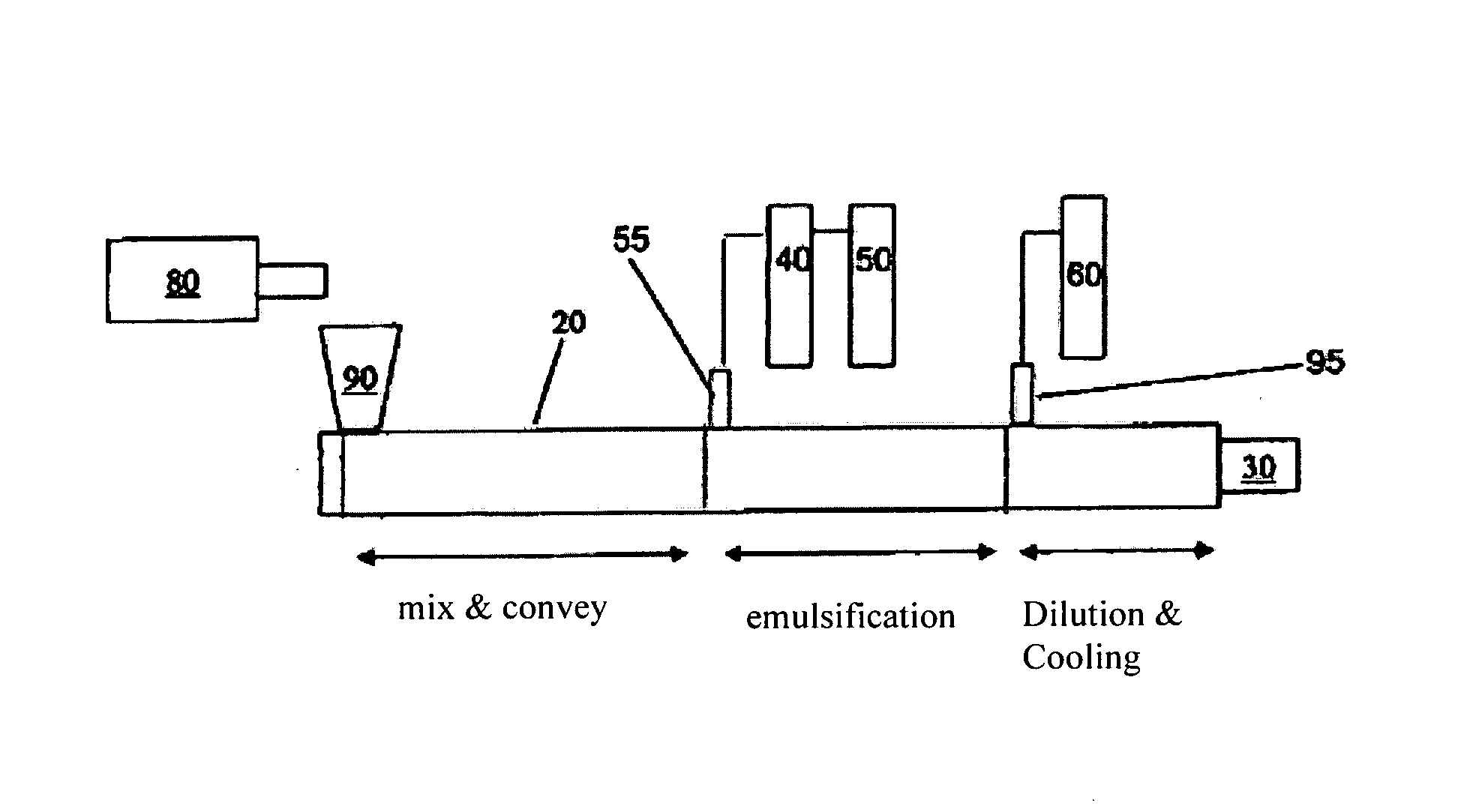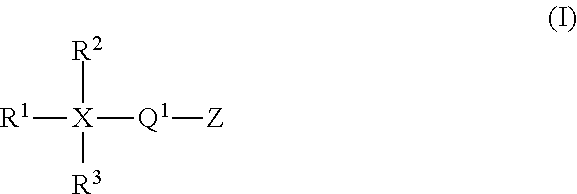Desensitized aqueous thermoplastic polymer dispersions
a thermoplastic polymer and dispersion technology, applied in the direction of synthetic resin layered products, coatings, chemistry apparatus and processes, etc., can solve the problems of unsuitable ingredients for use in intended formulated products, significantly higher viscosity of agglomerates
- Summary
- Abstract
- Description
- Claims
- Application Information
AI Technical Summary
Benefits of technology
Problems solved by technology
Method used
Image
Examples
preparation 1
Preparation of pH 11 Aqueous Predispersion of Ethylene / 1-Octene Copolymer with Potassium Behenoate to Give Predispersion P1
[0155]Feed 10,000 parts ethylene / 1-octene copolymer (ENGAGE® 8200) into a resin hopper of a polymer extruder (extruder model number ZSK 26 MEGAcompounder PLUS (McPLUS), manufacturer name Coperion Corp., Ramsey, N.J., USA) together with 300 parts (active weight) of dispersant (Behenic acid, a dispersant containing a 22 carbon chain fatty acid as active component), and melt-knead by a single extruder at about 160° C. to give a molten polymer / behenic acid blend (molten blend). Thereafter, into the barrel of a twin-screw extruder pump a solution of 32 parts potassium hydroxide dissolved in 398 parts deionized water into the molten blend under pressure and at a temperature of about 165° C. As the molten blend / aqueous KOH mixture passes down the barrel of the extruder, add deionized water until producing a predispersion having about 40 wt % to 60 wt % solids. Cool the...
preparation 2
Preparation of pH 11 Aqueous Predispersion of Ethylene / 1-Octene Copolymer with Potassium Salt of UNICID™ 350 Acid to Give Predispersion P2 (i.e., 8101-PETROSTEP SB)
[0158]Prepare the predispersion using ethylene / 1-octene copolymer (ENGAGE® 8200), UNICID™ 350 Acid (having a melting point of 92° C. by ASTM D-127; a penetration at 25° C. of 9 dmm by ASTM D-1321; a viscosity at 149° C. of 4 centipoise by ASTM D-3236; and an acid number of 120 milligrams KOH per gram sample by BWM 3.01 A), and potassium hydroxide in a manner similar to the procedure of Preparation 1 to give predispersion P2. Predispersion P2 (i.e., 8101-PETROSTEP SB; data are from ICD) has pH >9 and a 45 wt % solids content. The solids are 97 wt % ethylene / 1-octene copolymer and 3 wt % potassium salt of UNICID™ 350 Acid. The ethylene / 1-octene copolymer a particle size volume mean (i.e., average particle size based on volume) of 0.912 micron according to PROCEDURE PSM.
preparation 3
Preparation of pH 11 Aqueous Predispersion of Ethylene / 1-Octene Copolymer with Ethylene-Acrylic Acid Copolymer that is the PRIMACOR® 5980I Copolymer to Give Predispersion P3 (i.e., 8502)
[0159]Prepare the predispersion using ethylene / 1-octene copolymer (ENGAGE® 8200) and ethylene-acrylic acid copolymer that is PRIMACOR® 5980I copolymer (contains 20 wt % of acrylic acid residuals) in a manner similar to the procedure of Preparation 1, except using the PRIMACOR® 5980I copolymer instead of the behenic acid, to give predispersion P3. Predispersion P3 (i.e., 8502; data are from ICD) has pH >9 and a 42 wt % solids content. The solids are 85 wt % ethylene / 1-octene copolymer and 15 wt % ethylene-acrylic acid copolymer. Predispersion P3 contains 3 wt % of acrylic acid residuals (15 wt % times 0.20). The ethylene / 1-octene copolymer a particle size volume mean of 1.0 micron according to PROCEDURE PSM.
PUM
| Property | Measurement | Unit |
|---|---|---|
| Length | aaaaa | aaaaa |
| Percent by mass | aaaaa | aaaaa |
| Percent by mass | aaaaa | aaaaa |
Abstract
Description
Claims
Application Information
 Login to View More
Login to View More - R&D
- Intellectual Property
- Life Sciences
- Materials
- Tech Scout
- Unparalleled Data Quality
- Higher Quality Content
- 60% Fewer Hallucinations
Browse by: Latest US Patents, China's latest patents, Technical Efficacy Thesaurus, Application Domain, Technology Topic, Popular Technical Reports.
© 2025 PatSnap. All rights reserved.Legal|Privacy policy|Modern Slavery Act Transparency Statement|Sitemap|About US| Contact US: help@patsnap.com



